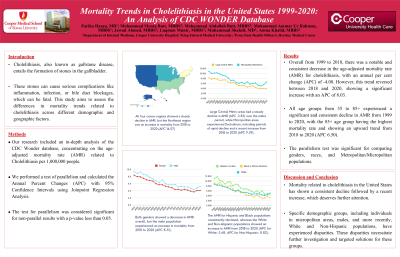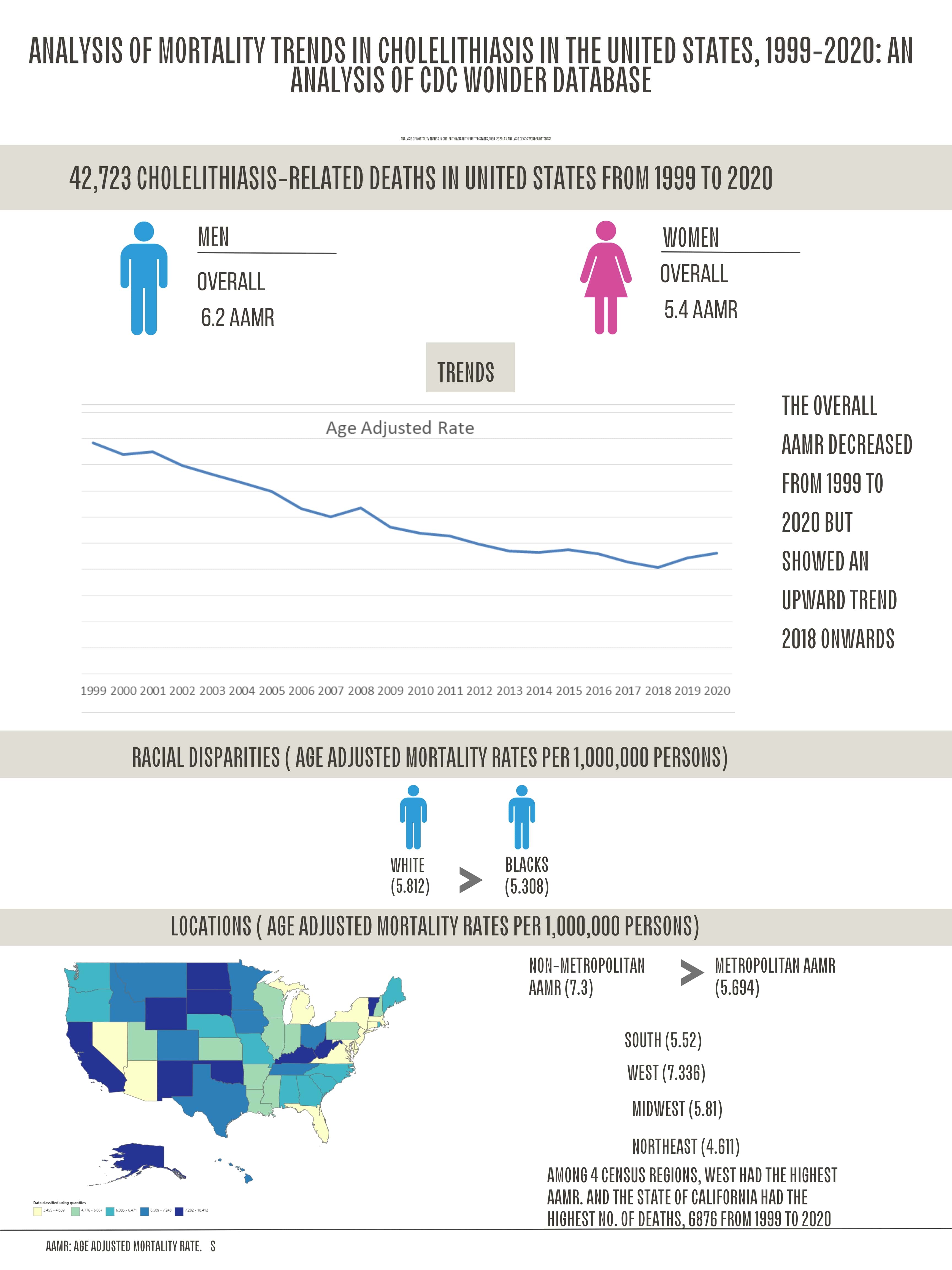Sunday Poster Session
Category: Biliary/Pancreas
P0036 - Mortality Trends in Cholelithiasis in the United States 1999-2020: An Analysis of CDC WONDER Database
Sunday, October 27, 2024
3:30 PM - 7:00 PM ET
Location: Exhibit Hall E

Has Audio

Fariha Hasan, MD
Cooper University Hospital
Philadelphia, PA
Presenting Author(s)
Fariha Hasan, MD1, Mohammad Moosa Butt, MBBS2, Mohammad Abdullah Butt, MBBS2, Muhammad Ammar Ur Rahman, MBBS2, Jawad Ahmed, MBBS2, Luqman Munir, MBBS2, Muhammad Shahzil, MD3, Amna Khalid, MBBS2
1Cooper University Hospital, Philadelphia, PA; 2King Edward Medical University, Lahore, Punjab, Pakistan; 3Penn State Health Milton S. Hershey Medical Center, Hershey, PA
Introduction: Cholelithiasis involves the formation of stones in the gallbladder, potentially leading to complications like inflammation, infection, or bile duct blockages, which can be fatal. This study aims to analyze mortality trends related to cholelithiasis from 1999 to 2020, focusing on national age-adjusted mortality rates (AAMRs). The goal is to identify disparities in disease progression and survival outcomes across diverse demographic and geographic groups.
Methods: Our research included an in-depth analysis of the CDC Wonder database, concentrating on the AAMR related to Cholelithiasis per 1,000,000 people. We performed a test of parallelism and calculated the Annual Percent Changes (APC) with 95% CI using the Joinpoint Regression program. The parallelism test was considered significant for non-parallel results with a p-value< 0.05.
Results: From 1999 to 2018, there was a consistent decrease in the age-adjusted mortality rate for cholelithiasis, with an annual percent change (APC) of -4.08. However, this trend reversed between 2018 and 2020, showing a significant increase with an APC of 8.03. All age groups from 35 to 85+ experienced a significant and consistent decline in AMR from 1999 to 2020, with the 85+ age group having the highest mortality rate and showing an upward trend from 2018 to 2020 (APC 6.50). All four census regions showed a steady decline in AMR, but the Northeast region saw an increase in mortality from 2018 to 2020 (APC 14.07). Large Central Metro areas steadily declined in AMR (APC -3.83) over the entire period. Micropolitan areas experienced fluctuations, including periods of rapid decline and a recent increase from 2018 to 2020 (APC 9.39). Both genders showed a decrease in AMR overall, but the male population experienced an increase in mortality from 2018 to 2020 (APC 8.51). The parallelism test was significant for genders, races, and Metropolitan/Micropolitan populations. The AAMR for Hispanics and Blacks consistently declined, whereas Whites and Non-Hispanics showed an increase in AAMR from 2018 to 2020 (APC 5.68 and 8.82, respectively).
Discussion: Mortality related to cholelithiasis in the United States has shown a consistent decline followed by a recent increase, which deserves further attention. Specific demographic groups, including individuals in micropolitan areas, males, and, more recently, White and non-Hispanic populations, have experienced disparities. These disparities necessitate further investigation and targeted solutions for these groups.

Disclosures:
Fariha Hasan, MD1, Mohammad Moosa Butt, MBBS2, Mohammad Abdullah Butt, MBBS2, Muhammad Ammar Ur Rahman, MBBS2, Jawad Ahmed, MBBS2, Luqman Munir, MBBS2, Muhammad Shahzil, MD3, Amna Khalid, MBBS2. P0036 - Mortality Trends in Cholelithiasis in the United States 1999-2020: An Analysis of CDC WONDER Database, ACG 2024 Annual Scientific Meeting Abstracts. Philadelphia, PA: American College of Gastroenterology.
1Cooper University Hospital, Philadelphia, PA; 2King Edward Medical University, Lahore, Punjab, Pakistan; 3Penn State Health Milton S. Hershey Medical Center, Hershey, PA
Introduction: Cholelithiasis involves the formation of stones in the gallbladder, potentially leading to complications like inflammation, infection, or bile duct blockages, which can be fatal. This study aims to analyze mortality trends related to cholelithiasis from 1999 to 2020, focusing on national age-adjusted mortality rates (AAMRs). The goal is to identify disparities in disease progression and survival outcomes across diverse demographic and geographic groups.
Methods: Our research included an in-depth analysis of the CDC Wonder database, concentrating on the AAMR related to Cholelithiasis per 1,000,000 people. We performed a test of parallelism and calculated the Annual Percent Changes (APC) with 95% CI using the Joinpoint Regression program. The parallelism test was considered significant for non-parallel results with a p-value< 0.05.
Results: From 1999 to 2018, there was a consistent decrease in the age-adjusted mortality rate for cholelithiasis, with an annual percent change (APC) of -4.08. However, this trend reversed between 2018 and 2020, showing a significant increase with an APC of 8.03. All age groups from 35 to 85+ experienced a significant and consistent decline in AMR from 1999 to 2020, with the 85+ age group having the highest mortality rate and showing an upward trend from 2018 to 2020 (APC 6.50). All four census regions showed a steady decline in AMR, but the Northeast region saw an increase in mortality from 2018 to 2020 (APC 14.07). Large Central Metro areas steadily declined in AMR (APC -3.83) over the entire period. Micropolitan areas experienced fluctuations, including periods of rapid decline and a recent increase from 2018 to 2020 (APC 9.39). Both genders showed a decrease in AMR overall, but the male population experienced an increase in mortality from 2018 to 2020 (APC 8.51). The parallelism test was significant for genders, races, and Metropolitan/Micropolitan populations. The AAMR for Hispanics and Blacks consistently declined, whereas Whites and Non-Hispanics showed an increase in AAMR from 2018 to 2020 (APC 5.68 and 8.82, respectively).
Discussion: Mortality related to cholelithiasis in the United States has shown a consistent decline followed by a recent increase, which deserves further attention. Specific demographic groups, including individuals in micropolitan areas, males, and, more recently, White and non-Hispanic populations, have experienced disparities. These disparities necessitate further investigation and targeted solutions for these groups.

Figure: Mortality Trends in Cholelithiasis in the United States 1999-2020 from the CDC WONDER Database
Disclosures:
Fariha Hasan indicated no relevant financial relationships.
Mohammad Moosa Butt indicated no relevant financial relationships.
Mohammad Abdullah Butt indicated no relevant financial relationships.
Muhammad Ammar Ur Rahman indicated no relevant financial relationships.
Jawad Ahmed indicated no relevant financial relationships.
Luqman Munir indicated no relevant financial relationships.
Muhammad Shahzil indicated no relevant financial relationships.
Amna Khalid indicated no relevant financial relationships.
Fariha Hasan, MD1, Mohammad Moosa Butt, MBBS2, Mohammad Abdullah Butt, MBBS2, Muhammad Ammar Ur Rahman, MBBS2, Jawad Ahmed, MBBS2, Luqman Munir, MBBS2, Muhammad Shahzil, MD3, Amna Khalid, MBBS2. P0036 - Mortality Trends in Cholelithiasis in the United States 1999-2020: An Analysis of CDC WONDER Database, ACG 2024 Annual Scientific Meeting Abstracts. Philadelphia, PA: American College of Gastroenterology.
